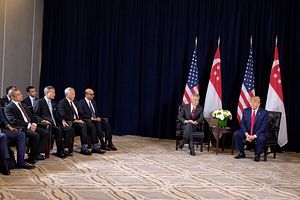Earlier this week, Singapore and the United States renewed an agreement, originally inked back in 1990, that facilitates the U.S. use of defense-related facilities in Singapore. While the move itself was not surprising, it nonetheless highlighted an important aspect of the security ties between the two countries amid wider domestic and regional trends and developments.
Singapore and the United States have long had a defense relationship as part of what is officially termed as a strategic partnership. The United States is a key supplier of defense technology and facilities for military training for Singapore, while the city-state is a valuable regional partner across a range of issues from counterterrorism to maritime security.
Additionally, Singapore has allowed Washington some use of its military facilities over the years. While there are several facets to this, one of the foundational agreements for this was the 1990 memorandum of understanding (MOU) regarding U.S. use of facilities in Singapore, which was signed by Singapore’s founding premier Lee Kuan Yew and then-U.S. Vice President Dan Quayle.
The 1990 MOU facilitated U.S. forces’ access to Singapore’s air and naval bases as well as the provision of logistical support for transiting personnel, aircraft, and vessels for exercises, refueling, and maintenance. But from a more strategic perspective, coming toward the end of the Cold War where there had been questions about the future of the U.S. presence in Asia and amid other subsequent developments such as the closure of U.S. bases in the Philippines, the agreement was seen as a key way to reinforce Washington’s regional security presence.
Over the years, the 1990 MOU – last renewed during the first round of its 15-year expiry the George W. Bush administration in 2005 – has played an important role in facilitating U.S. presence in Asia as well as Singapore’s involvement in U.S. Asia strategy. During the Obama administration’s rebalance to Asia, for instance, Washington deployed littoral combat ships (LCS) and P-8 Poseidon aircraft to Singapore in one of the security manifestations of that strategy, amid other related developments as well including the conclusion of an enhanced defense cooperation agreement (Enhanced DCA) where both sides looked to advance cooperation in newer areas.
This week, this aspect of the relationship was in the headlines again with a renewal of the 1990 MOU regarding the U.S. use of facilities in Singapore. Singapore Prime Minister Lee Hsien Loong and U.S. President Donald Trump signed the protocol of amendment to the 1990 MOU (2019 AMOU) regarding the U.S. use of facilities in Singapore during Lee’s visit to New York, thereby renewing the 1990 MOU and extending it for another 15 years.
The move itself comes as little surprise. As noted previously, Singapore has long been a rare example of a non-allied supporter of a strong U.S. security presence which is willing to back this up by hosting a U.S. military presence, and it continues to see this as being beneficial for its own interests as well as for regional stability. The agreement itself was also due for a renewal since the last in 2005. Both sides had already effectively agreed to do so earlier this year, and moving forward with it sooner rather than later would make sense given the uncertainties ahead in the domestic politics of both sides, with the United States heading into an election year in 2020 and Singapore moving further into a transition away from current Prime Minister Lee Hsien Loong.
Yet it is also not without significance. For the United States, the renewal of the agreement reinforces one of the key U.S. access points in the Asia-Pacific at a time when some existing ones have been difficult to sustain and newer ones have been challenging to find, even as it advances its Free and Open Indo-Pacific strategy. And for Singapore, it sends a clear signal about its ability to balance security ties with the United States and China amid growing U.S.-China competition, with the renewal of the U.S. agreement coming just a few months after Singapore indicated it was moving forward on a revised defense agreement with China, which had led to additional scrutiny about the Southeast Asian state’s alignments (despite the fact that U.S. security ties with Singapore far outpace what China currently has in place, and inroads with Beijing have also come amid significant concerns about aspects of its behavior). More broadly, as Lee himself noted in his remarks on the signing, it reaffirms Singapore’s role in providing a way for Washington to deepen its engagement in Southeast Asia and the wider Asia-Pacific.
To be sure, the renewal of the agreement itself can belie some of the present and future challenges for the relationship that can also impact aspects of defense relations. For several partners of the United States including Singapore, it has been concerning that the Trump administration has sought to advance its FOIP strategy even as Trump himself has raised questions about U.S. competitiveness and Washington’s commitment to aspects of freedom and openness. And looking further ahead, while Singapore has been a consistent supporter of a strong U.S. security role in Asia, several variables, including Singapore’s changing domestic politics and shifts in the balance of power in Asia, could also lead to changes in the level and nature of that support as further renewals are negotiated in the 2030s and the 2040s.
All this does not take away from the significance of the renewal. But it does mean that even as this constitutes a gain for U.S.-Singapore relations and a reminder of Singapore’s importance to U.S. Asia strategy, it should be viewed in relation to the wider relationship and with an eye on future developments within both countries as well as in the broader region.
































